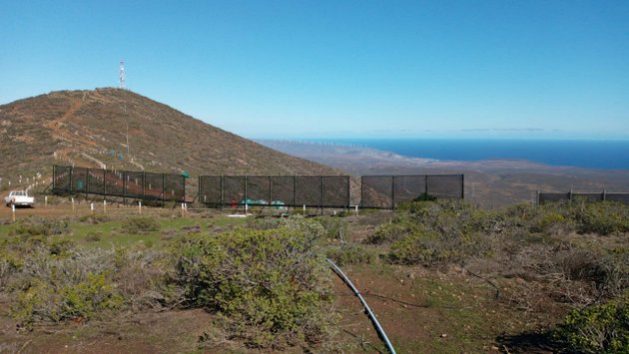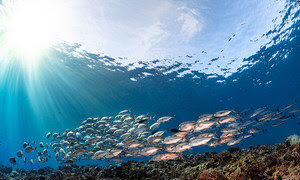By Orlando Milesi
OVALLE, Chile, Jul 15 2020 (IPS) – “The harvested water has helped us at critical times and the fog nets have also brought us visibility. Today we produce beer here and many tourists come,” says Daniel Rojas, president of the Peña Blanca Agricultural Community in Chile. Located in the south of the Coquimbo region, 300 km north of Santiago, Peña Blanca is suffering a brutal drought and faces the threat of becoming part of the Atacama Desert by 2050, the United Nations Convention to Combat Desertification (UNCCD) warned two years ago.
In Peña Blanca until 2000, water ran off the surface, and the villagers had dikes to take turns to use the water,” Nicolás Schneider, a geographer with the “Un Alto en el Desierto” (A Stop in the Desert) Foundation, the NGO behind the installation of fog harvesters in the region, told IPS.
The official record of rainfall in the municipality of Ovalle, in the basin of the Limarí River, the main river in Coquimbo, indicates an annual average of just 102.6 millimetres in the last 30 years.
But in 2018 the average fell to 38.1 mm, and in 2019 to just 8.5 mm. In June, three non-consecutive days of rain were greeted with joy because they totalled more rainfall than in all of 2019.
Coquimbo is home to 771,085 people, 148,867 of whom live in rural areas. It is the southern border of the Atacama Desert, the driest desert on earth which has the most intense solar radiation on the planet. It encompasses six northern regions in this long, narrow country that stretches between the Andes Mountains and the Pacific Ocean and has a population of 18.7 million people.
“I am a livestock breeder and I also organise events for delegations that visit the fog nets in Cerro Grande,” Claudia Rojas, who at 53 is making the shift from livestock raising to a tourism microenterprise, told IPS.
“I was born and raised in Peña Blanca and I wouldn’t change it for any other place. Now I have only a few goats (20) and sheep (60). I had up to 200 goats but I have been reducing the herd because there is not enough natural pasture,” she said.
“I hope to continue receiving delegations when the pandemic is over. I serve them cheese, roasted kid (young goat) and local products. At my house or in the reserve,” she said.
What Claudia loves the most are the visits by hundreds of schoolchildren “who are happy to see nature.”
“From up above they can see the (Andes) mountain range and on the other side the sea. The main characteristic here is the fog. And they are amazed when the fog reaches the hill and they see how the water is harvested,” she said.
The Agricultural Community of Peña Blanca, made up of 85 families, has 6,587 hectares, 100 of which constitute the Cerro Grande Ecological Reserve, where the fog harvesters were installed 15 years ago. Back then, many locals could not imagine the impact and benefits the nets would have.
“They have made us well-known and that has brought the community resources for other projects,” said its president, Daniel Rojas, 60 (no relation to Claudia or other sources with the same surname, which is common in the area).
In Chile, the “agricultural community” is a legal figure for the collective property and usufruct of the land, in which the community members are given portions of land to use while another part is collectively managed.
“We have harvested a significant amount of water that has helped us in difficult times. At first to irrigate the vegetation and reforest with native species, and then to water the animals. We built a drinking trough, piping the water two km downhill.”
“Later, a 10,000-litre tank was made to collect water for people living nearby, to use when the tanker truck does not come,” he said.
Eight years ago, Peña Blanca beer began to be brewed, made with fog water, which is softer. Its light (Scottish) and dark (Brown) versions competed at the 2015 ExpoMilan and won the audience award.
Mario Alucema, 59, also born and raised in Peña Blanca, works in the artisanal brewery.
“Our beer made with 100 percent fog water is popular and successful. It has drawn attention to our farming community. I work (in the brewery) every (southern hemisphere) summer and receive 30 tourists a day, from Argentina, Brazil and other countries,” he told IPS proudly.
The plant produces 2,500 litres a week, and production is set to increase because the plant will be expanded.
“When these young entrepreneurs showed up I said to myself: ‘Who’s going to come all this way for the beer?’ We’re a long way from the Pan-American Highway. Then I thought, ‘Who’s going to drink this beer?’ And third, I thought it was money laundering. But everything was the other way around. Today, in the midst of this global pandemic, they’re still coming for the beer,” he said.
Daniel Ogalde, 47, who is also from Peña Blanca, has been the park ranger since March. He is dedicated to the maintenance, irrigation and replanting of native species in the ecological reserve.
“My idea is to be here for a long time. Because of the coronavirus, visits are suspended, but in August we plan to restart them,” he told IPS, adding that the reserve “is a source of pride for the community and everyone is concerned about its care and maintenance.”
Guido Rojas, 58, lives in Peña Blanca but works at the nearby lookout point at the Talinay Wind Park, owned by the ENEL Green Power company. “Harvesting water helps us because there have been many dry years,” he said.
The experience “has been maintained by the support of the community and the people who live here,” he added.
A qualitative leap has been made since July. The United Nations Development Programme (UNDP) has granted 40,000 dollars to renovate and build fog nets, install lookouts, paths, signage and toilets. The programme ends on Dec. 31.
Since it was created in 2006, the reserve has had 24 fog-catchers, with a total of 216 square metres of double-layer 35 percent Raschel mesh.
“The expansion consists of the repair of 12 and the construction of 16 new fog nets. We will have 28 totalling 252 square metres, to harvest water,” said Un Alto en el Desierto’s Schneider.
Now 1,537 litres of water will be harvested per day, he explained.




